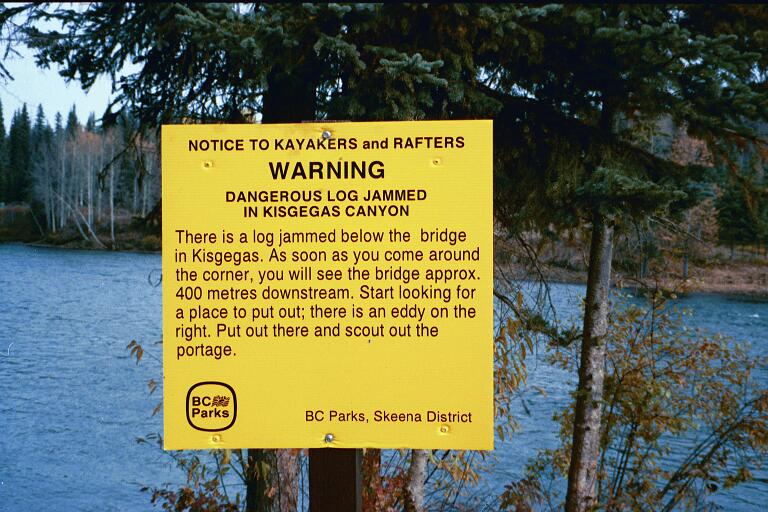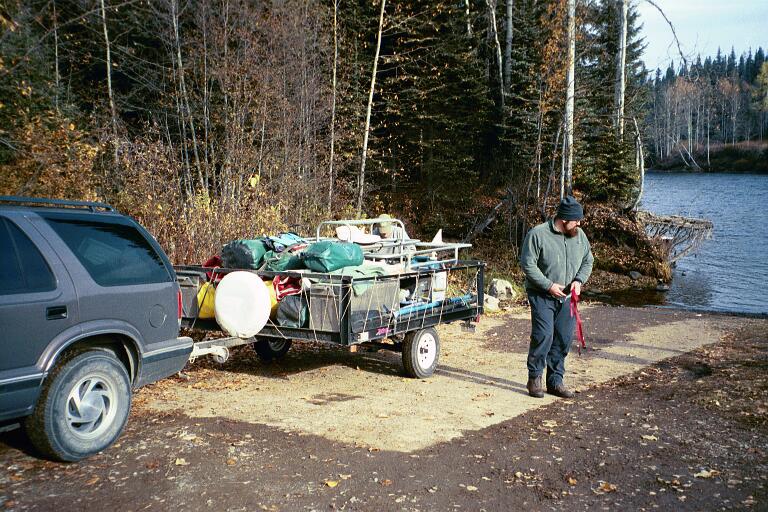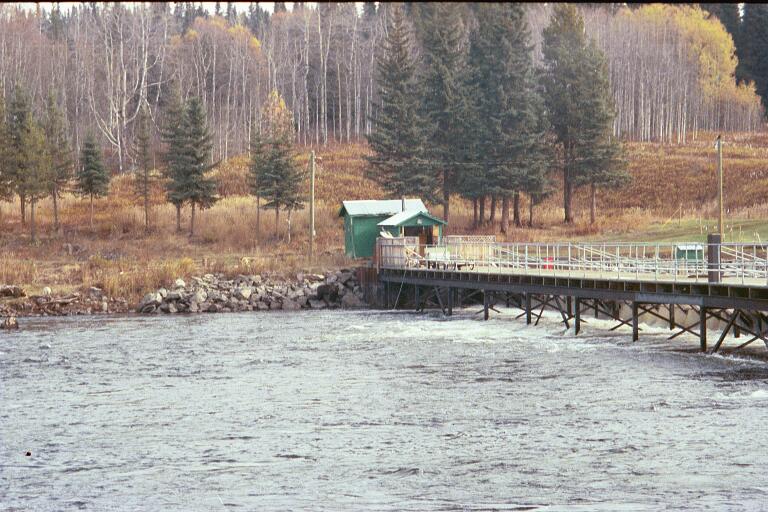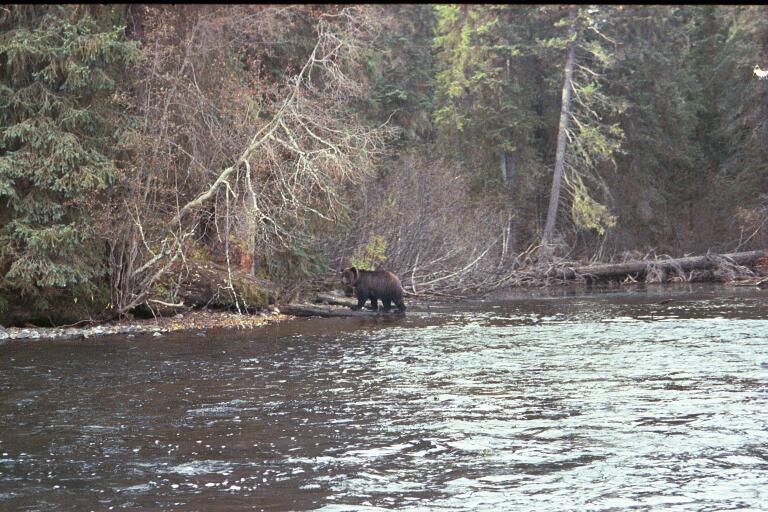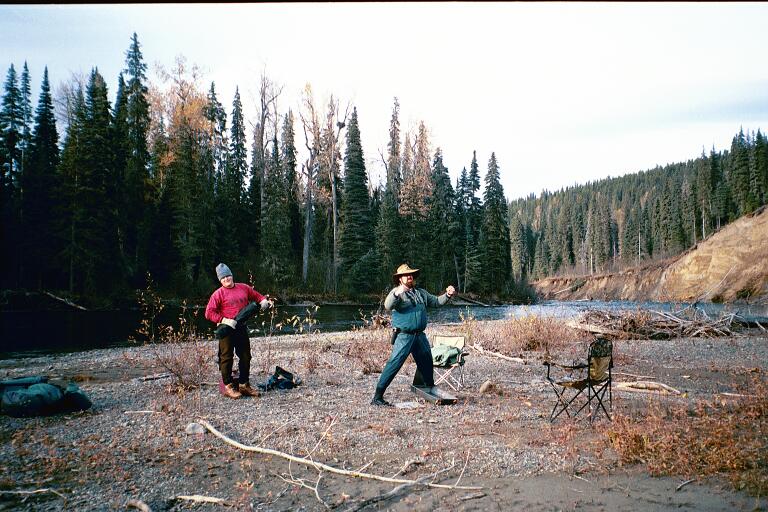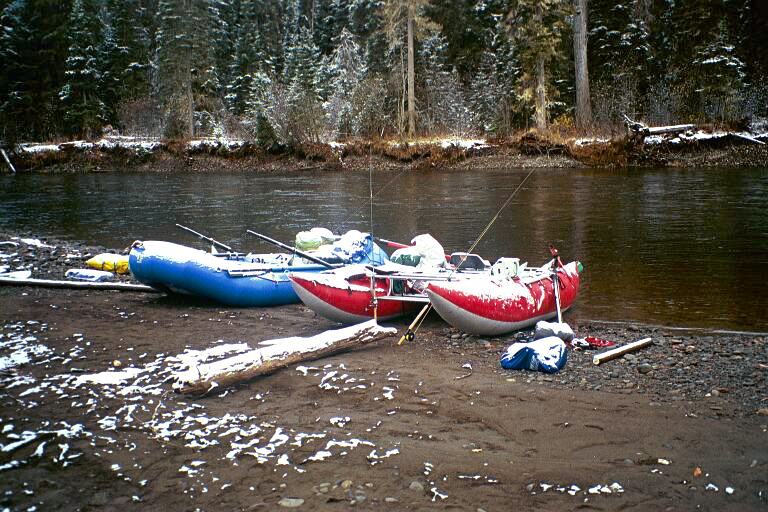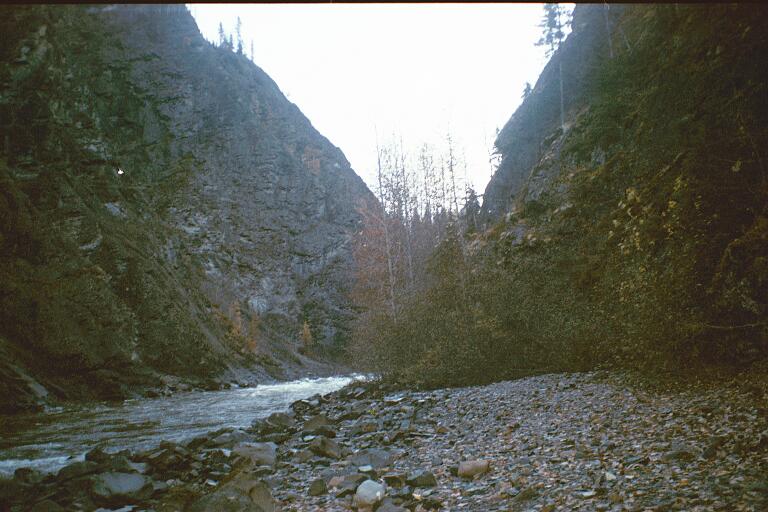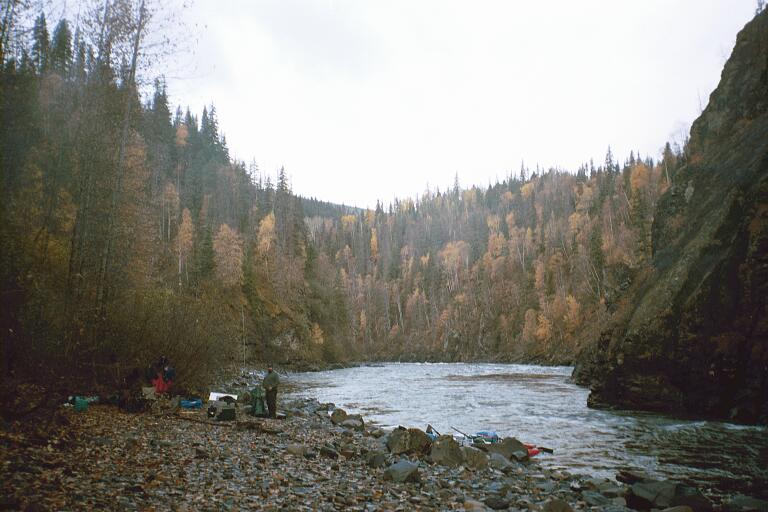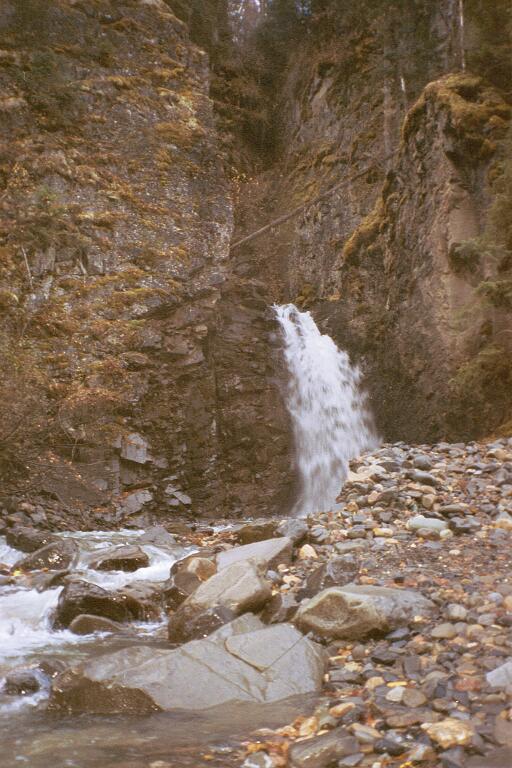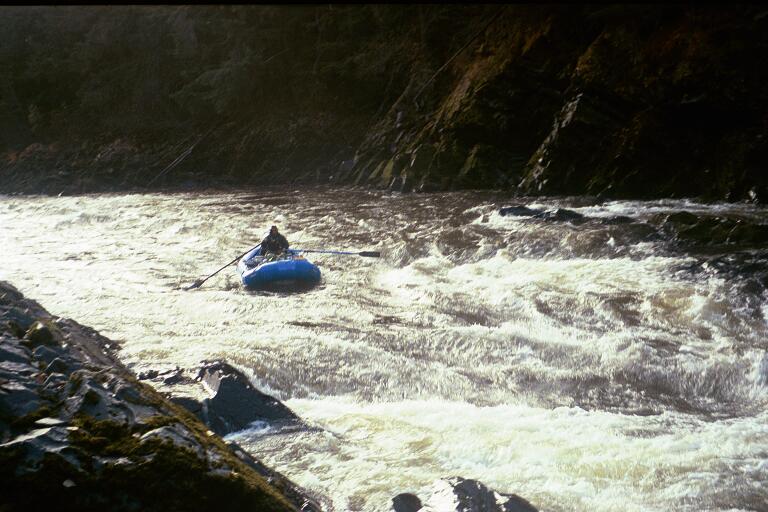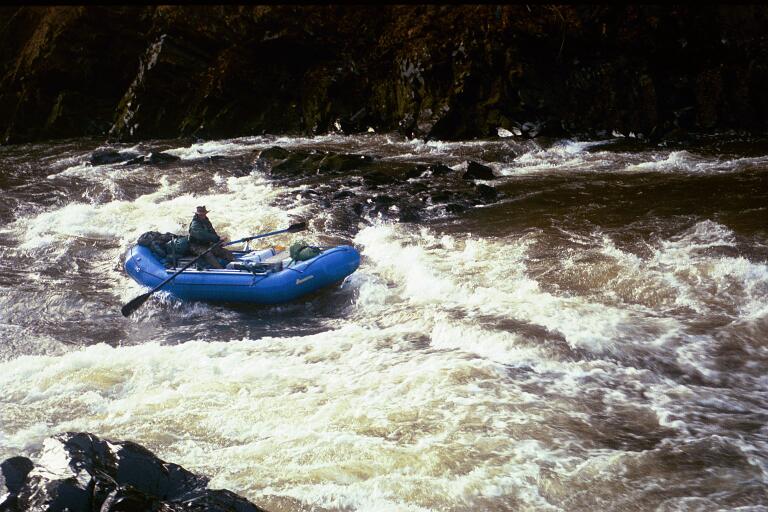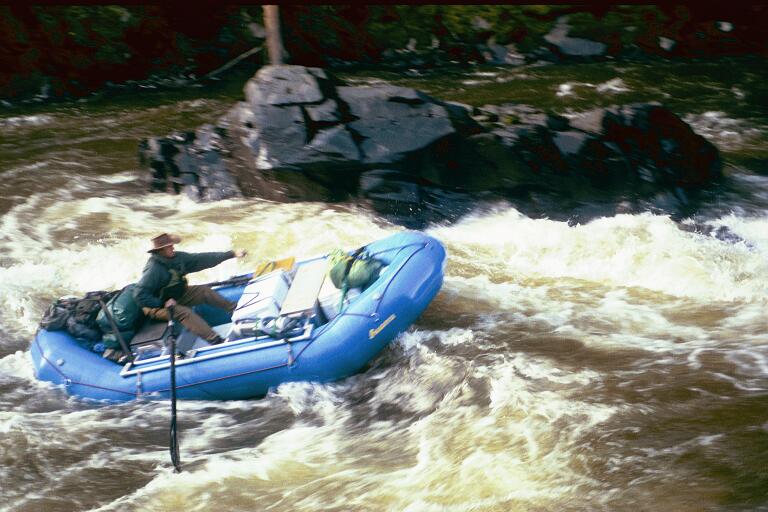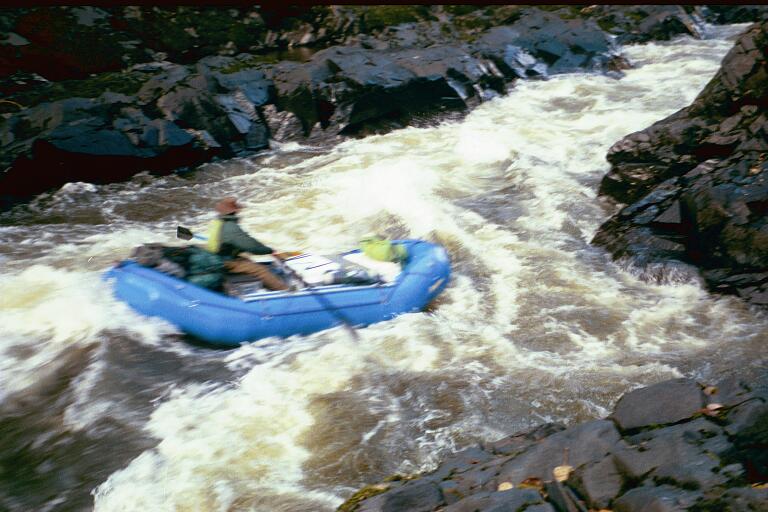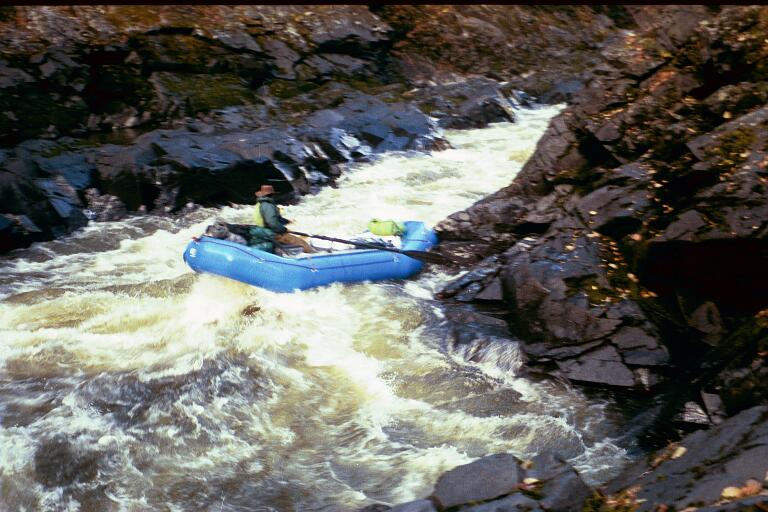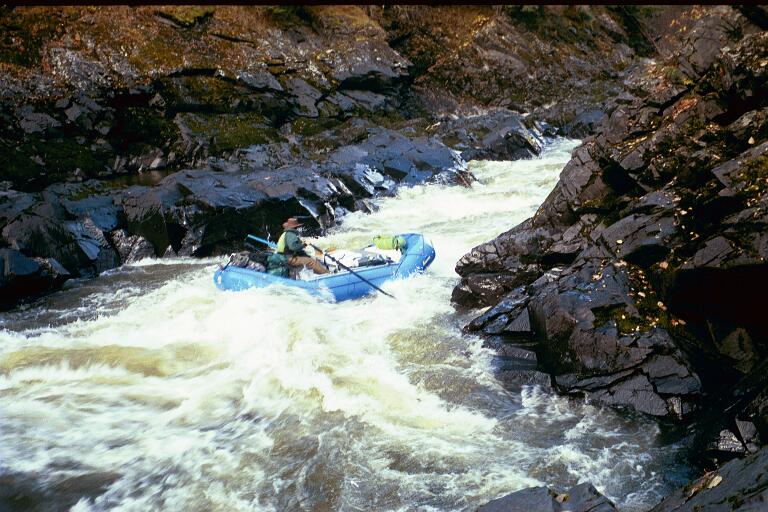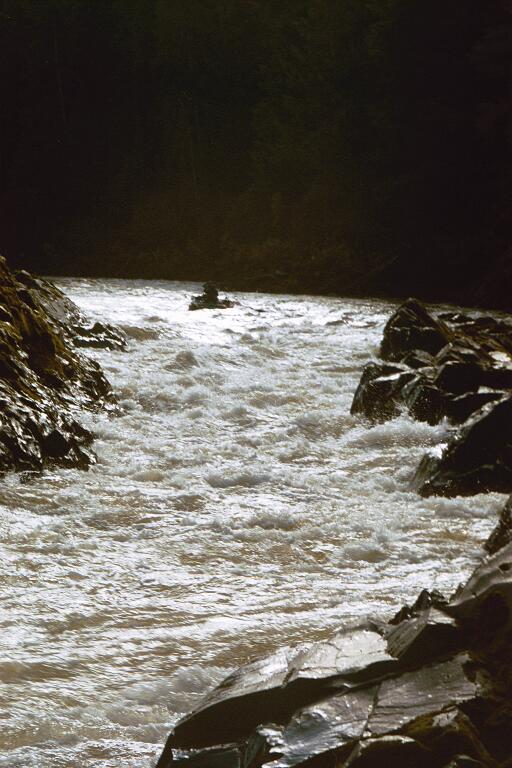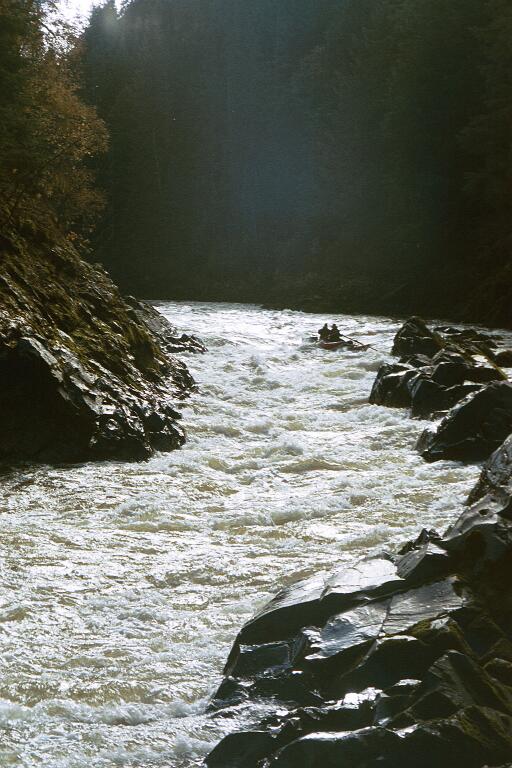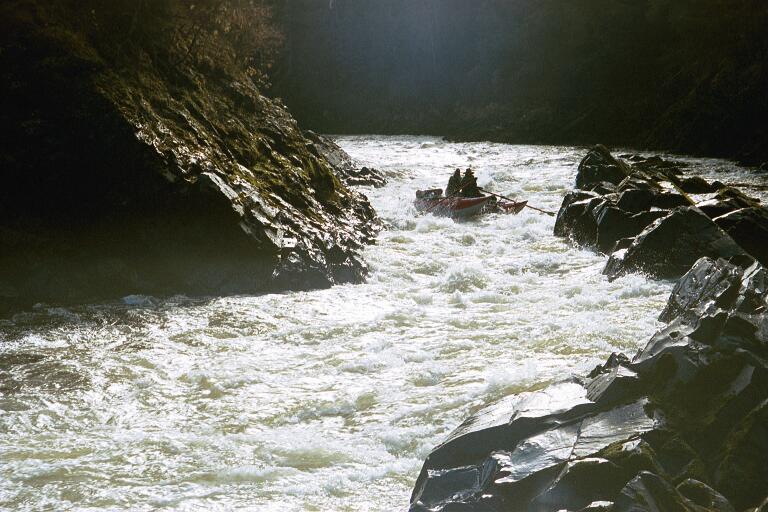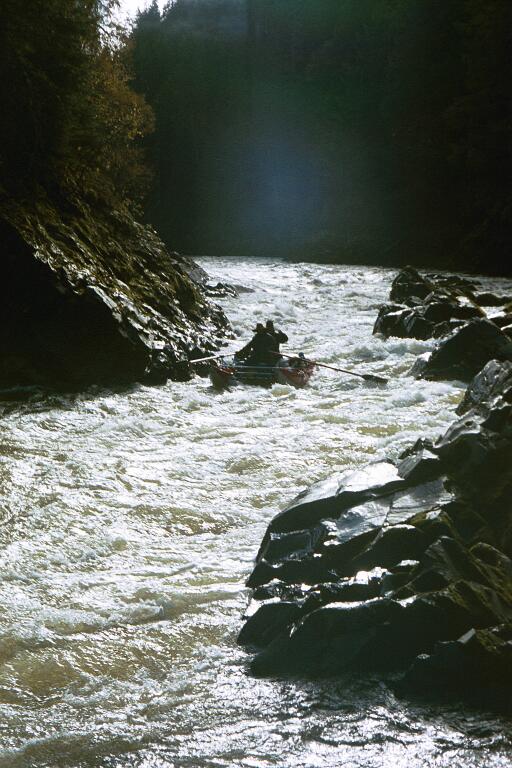Day 0 – Boise, ID to Portland, OR to Smithers, BC
It was late October 2003, and I was going to graduate school in Portland, while Derek and Ben where working in Boise, ID. While always a dream, the trip was planned a couple months in advance and Ben was a last minute addition. Ben had an early 90’s Chevy Blazer that was to pull a 10-foot trailer full of raft gear. The plan was to have Ben and Derek drive six hours from Boise to Portland to pick me and my pile of rafting gear up and the three of us would drive the 17 hours straight through from Portland to Smithers, BC. We would each take turns driving while the others slept. After a border crossing, a wrong turn, a sit-down breakfast, and a grocery run for the trip, it took 22 hours to arrive.
Our plan was to do a non-guided float from Babine Lake down the Babine River and the mighty Skeena River and float 7 days and about 80 miles to the small Native village of Kispiox. I would float a 16 foot Aire cataraft carrying gear and a passenger (Ben), and Derek would float a 15 foot Maravia raft with only gear. The Babine/Skeena system is known for producing large steelhead some reaching into the 20-pound range, which we witnessed. The Babine is also known for having numerous class III and IV rapids that ended up testing us.
Day 1 – Put-in to Island Group Camp
Prior to our trip, Derek scheduled a shuttle for the vehicle. The driver claimed that leaving your rig parked in Kispiox was not safe, so he offered to keep it at his house. The put-in was about 1-2 hour dirt road drive out of Smithers. Upon arriving to the river, we could see a large number of anglers standing on the bridge looking down into the river below. I asked the driver if he knew what was happening here. “Bears in the river!”, said the driver. We turned before the bridge to a concrete boat ramp and the first thing we noticed was a sign. This sign made us hesitate for a minute, but we’ve come so far and we weren’t about to turn back.
As we unloaded the trailer to start building rafts, a fisherman came out of the bush. “Better get. Bears coming!”. “Singular or plural?” was my first thought. So we followed the fisherman up to the outhouse to hide out.
We never did see the bear come out, but the angler pointed out another bear on the opposite bank that was rather large, yet not an immediate threat. We watched for bears for about 20 minutes and moved back to building boats.
An hour blowing up boats and strapping things down and we were off. Our first few obstacles in the river were anglers standing in shallow water fishing to deeper water. We needed the deeper water so they weren’t happy with us floating through their fishing water. About 100 yds downstream of the boat ramp, we saw the bear we ran from earlier.
Our first camp, Island Group Camp, was 11.5 miles from the put-in, which we arrived at in the late afternoon. A spey angler was wading the bottom of the run that extended the length of the camp. The camp appeared to be an island only at low water and mostly consisted of river stones. We set up camp and right before dark a small flat-bottomed boat came and picked up the angler. We also found large grizzly tracks on the island which didn’t help me sleep. Here’s a picture of us as we set up camp, and yes I was excited!
Day 2 – Island Group Camp to Eagle Bluff Camp
No bears payed us a visit that night. We awoke to a skiff of snow. Overall, the weather treated us very well over the week, but we thought snow on the first morning meant for a long seven days. There were some wet drizzly days, but this was the only snow that we saw during the week. Not bad for the third week of October in British Columbia.
The scenery on Day 2 was beautiful, yet the float was chilly. Our destination was Eagle Bluff camp about 24 miles away and we would face our first series of rapids. There are two main Steelhead lodges on the Babine River that cater to guests. Helicopters fly clients to expensive lodges and small jet sleds motor clients up and down the river to famous steelhead runs scattered throughout. These lodges never fight over fishing holes because the first lodge, Babine Steelhead Lodge, is above a series of rapids its boats cannot get around. The second lodge, the Silver Hilton, is below the impassable rapids. This rapid is known as “The Ledge Rapid”. Four class 2/3 read and run rapids were encountered on Day 2 with great fun and no carnage. Eagle Bluff campground was river-right with a sandy beach across from a rock bluff. There was plenty of tent sites in the bush above the beach.
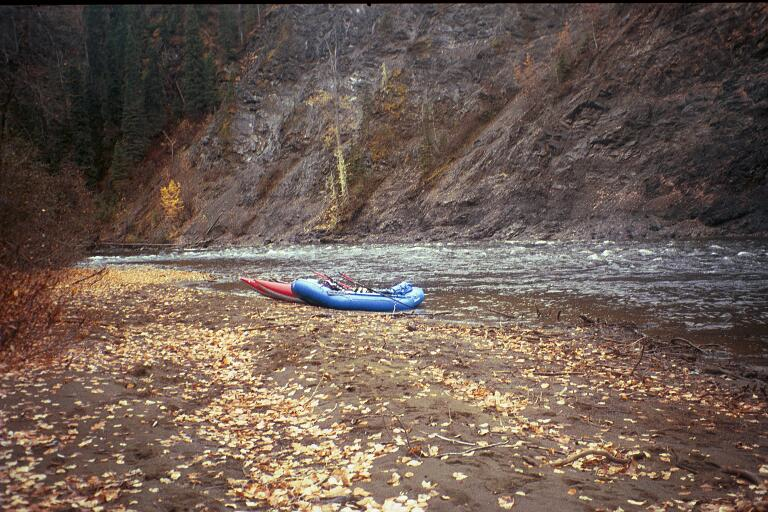
We layed over an extra day at this camp for some fishing. There was a nice run right in front of the camp. On our layover day, a guide in a jet sled pulled out to chat with us saying he wanted to make sure we were being good campers. We showed him our fire pan, toilet, and spey rods and he was satisfied.
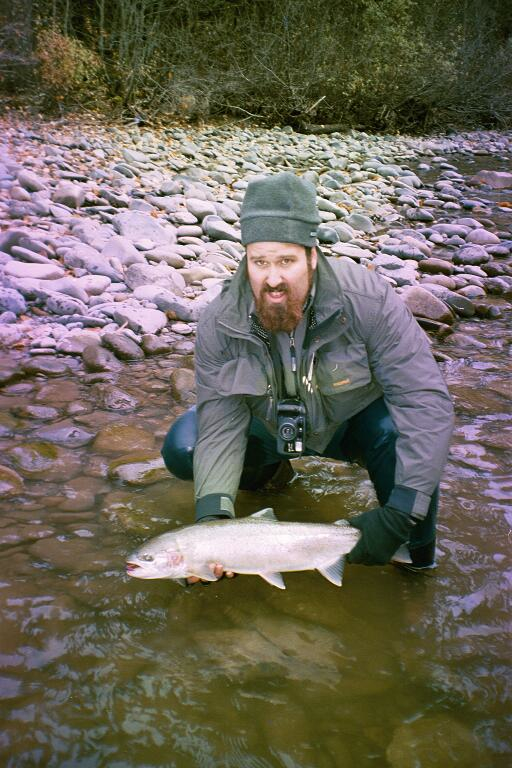
Day 4 – Eagle Bluff to Shelagoyte River Camp
This section has some great scenery and some good fishing holes over the 15 river miles. There were no rapids in this section. Our destination camp was on river right on a large gravel bar that fans out from Shelagoyte River, which is one of the larger tributaries to the Babine. The Silver Hilton Lodge was less than a mile downstream and we saw wading anglers near our camp. It was a full moon that night and there was plenty of drift wood on the gravel bar. Take wood with you to Slide camp because there is no wood options there.
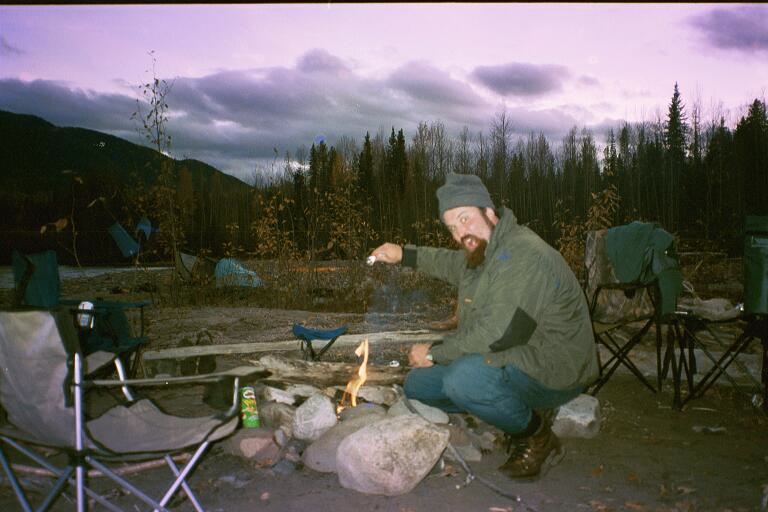
Day 5 – Shelagoyte River to Slide Camp
Day 5 was a twenty mile float with six class III rapids. We stopped for lunch near Len’s Hole. Ben was a gear hucker and went to the bottom of the hole while Derek took his spey rod and went to the head of the run. I was making sandwiches, when Ben started screaming. His first chrome of the trip. Ben had a big fight on his hands and went to help. I landed Ben’s fish, which he caught on a spoon. It was the biggest steelhead I’ve ever seen with my own eyes. Easily a twenty pound steelhead. I had a camera around my neck and told Ben to grab it and take picture. His ego kicked in and told me to hand hime the fish and take a picture. With the spoon still in the monster’s mouth, I handed him this fish. Of course, Ben was inexperienced and the slab wiggled and Ben couldn’t hang on. It went right between his legs and his gear rod rainbowed to the point of breaking. “POP!”, fish released without a picture. Meanwhile, Derek had the world’s smallest steelhead on at the top of the run.
We moved on to our next camp carefully. We had to hit Slide Camp if we didn’t want problems with Grizzly Bears in our camp. We knew Slide Camp was at the bottom end of Slide Rapid and it was an easy to miss camp because you spent time looking back at the rapid. We were also told that Slide Rapid had “zipper rocks” which were sharp enough to rip open a boat. We performed a “read and run” and saw the zipper rock, which was not a lie. Slide camp was on river left and it was close to the end of the rapid, but not a hard pull since we had the knowledge. The camp was at the head of a canyon that you’ll float until you reach the Skeena. Here’s a picture of the camp looking upriver.
Below is Slide Camp looking downriver
The camp was not ideal for a large group as the beach was rocky and most tent spots were back up towards the cliffs. We setup and had a nice freezing shower under the campside waterfall with a huge fire to warm up. Bring your own wood to this camp from Shelagoty Camp.
Below are necessities to carry into Slide Camp. Wood and beer.
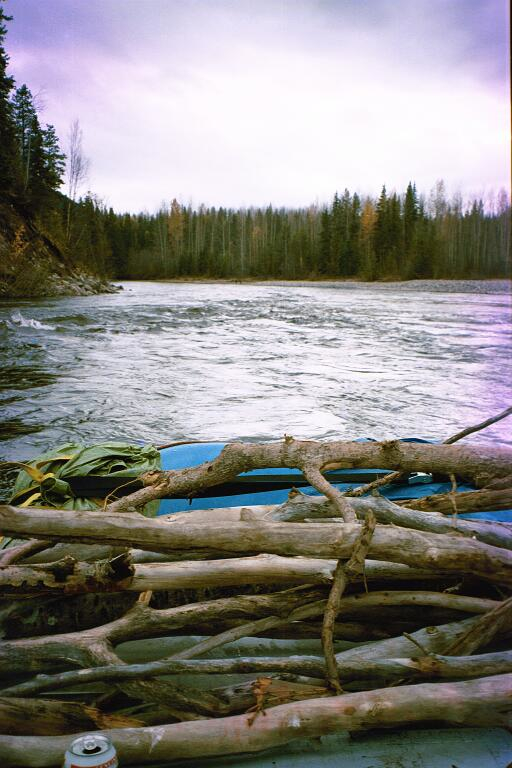
We didn’t sleep well at this camp. Anxious that tomorrow we had a series of challenging rapids that bears fished from, and the put-in sign indicated we had a Kinegas Canyon portage coming.
Day 6 – Slide Camp to Rescue Camp
The day started overcast and cold. We had five miles to our first class IV rapid, Grizzly Drop. We were advised to scout this rapid and be careful during the scout. Bears fish this rapid on a regular basis and this section of river has a constant upstream breeze, so they can’t smell you coming. Without scent, coming in above the rapid would startle them causing us bear problems. Our plan was to exit our boats and blow an air horn to let the grizzlies know we were present. Supposedly, the rapid was five miles below Slide Camp, but at a little past 4 miles, I saw Derek scramble to move his boat and a split second later, it disappeared over the river horizon line. I was right behind him and realized Grizzly Drop was here and we had no choice, but “Read and Run”. River Left looked best and I could see Derek laughing after I took a hard hole hit from a reversal after a good 10 foot drop. No bears in the way but I saw a mama grizzly and two sow on river right run up the hill. This all happened so fast we didn’t get photos. Grizzly Drop felt similar to Velvet Falls on the Middle Fork of the Salmon, where you don’t hear it or see it until you’re running it. One down, three to go.
There is a camp about three or four miles below Grizzly Drop Rapid on river right, but the bear activity in this area would make this an emergency camp only. This camp is less than a mile above Sphicter I Rapid, a class III+. This is a fun narrow chute rapid, thus the name, where you just stay off the rocks and ride the train. The entry is intimidating because it is so narrow and you cannot see the entire line as seen below.
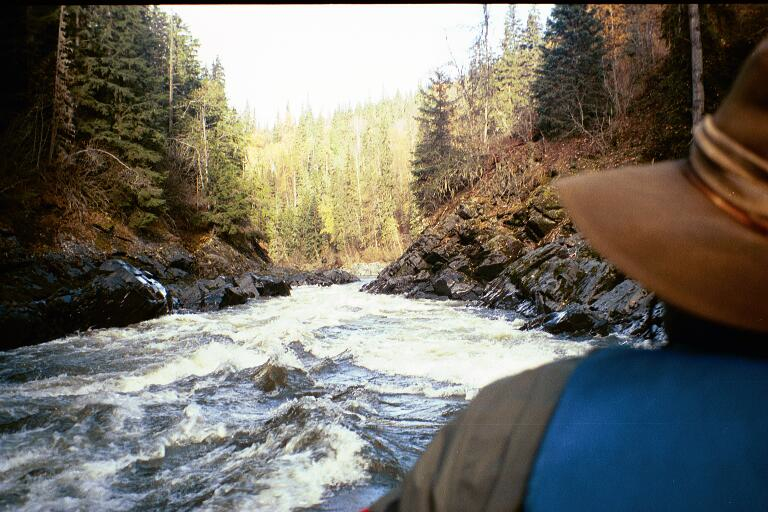
The scout doesn’t give you a good view of the enitre rapid from river right as seen below.
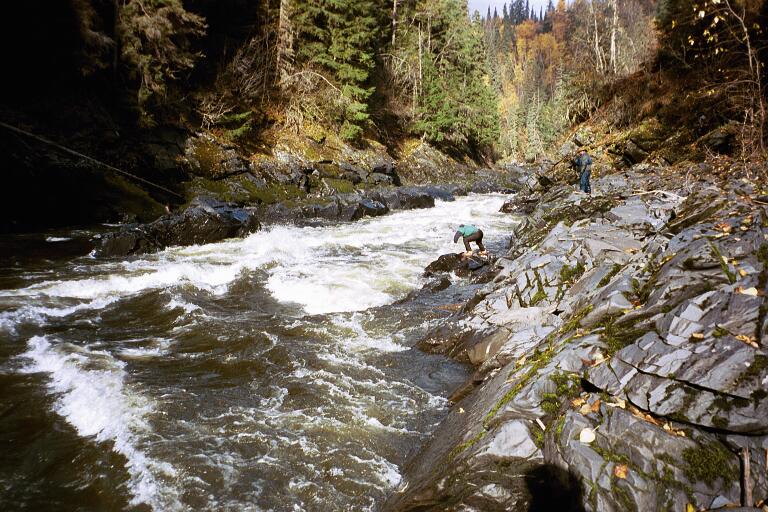
Derek went first with a nice entry and got very close to sphicter wall. We washed the shit off
his boat later.
After Derek’s run, he filmed us from the bottom giving a better perspective of the entire line through the rapid. Notice the drop in elevation, because you’re moving quick throught this one.
The sphincter gets tighter in another mile. We were told that Sphincter II was the biggest challenge on the river, rated at a Class IV+ and a little tricky at low water. Our informant told us to scout river right, blow the air horn, and be ready for bears. We followed our intel and got lucky there were no bears present. The drop was basically a tight constriction with an entry hole that naturally pushed you into a deadly undercut on river left. This undercut current pushed up into a large sticky boil on river right. It looked as if the run was to hit the entry hole dead on, ferry left, pull away from the undercut, and thread the needle between the undercut and the boil. As we scouted the rapid, I heard Ben yell, “Oh Shit!!”. We looked back and Derek’s raft was moving downstream towards the rapid……with nobody in the boat.
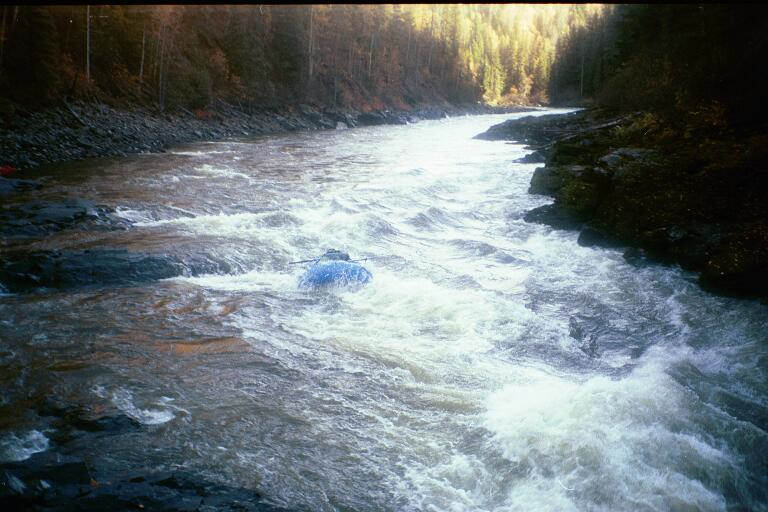
The ghost driving Derek’s boat lined up to the entry hole nicely.

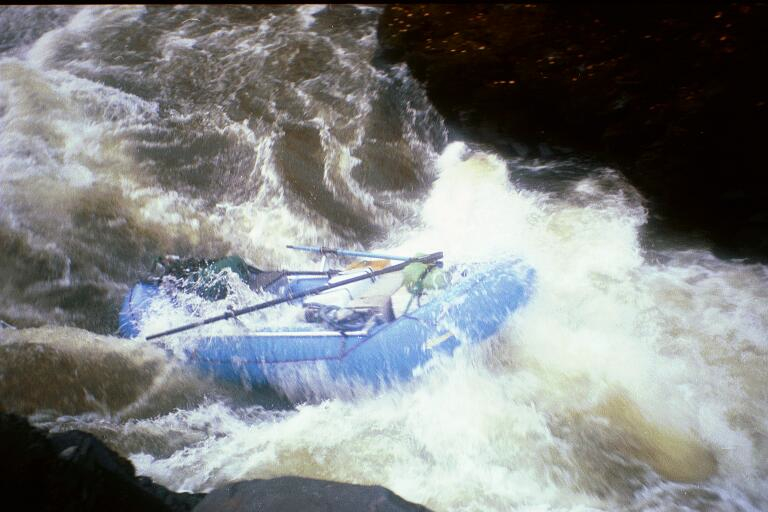

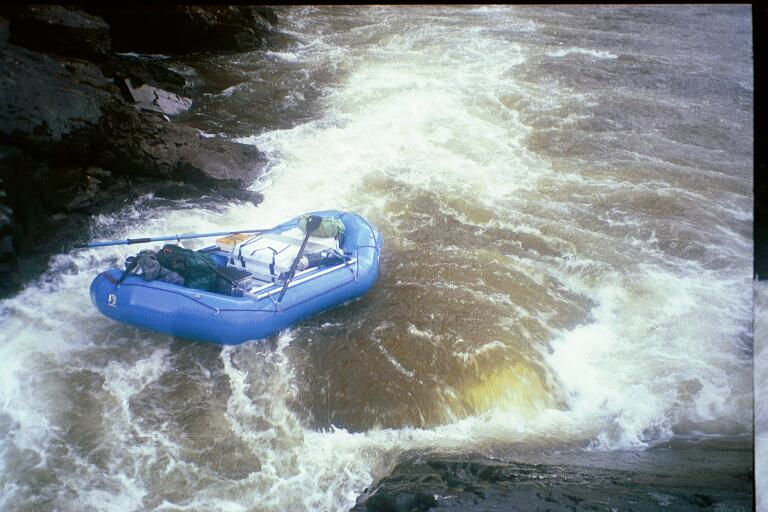
Derek’s boat had nice clean run with nobody rowing. I handed Ben a throw rope and told him to run safety. I looked at Derek wading in the river below the rapid up past his waist looking like he was going to swim for his boat. It was time for me to run this rapid and chase down Derek’s boat, and possibly Derek himself. I ran back up to the boat, did a quick check, and forward rowed as hard as I could. Adreline fueled forward rowing turned out to be problematic. I hit the entry hole with lots of speed and easily pushed through, but I had to much speed and needed to back row. Both back strokes hit the cliff rocks and I had so much speed, I went directly into the undercut. I knew I was in a bad place, but I tried to kick my feet off the rock. This made it worse. My cataraft was pinned in the undercut rock and it began inverting. I high-sided early enough to prevent an immediate flip, but it was unrecoverable. I reached up to grab a rock above me and pulled myself off the boat. I yelled to Ben to throw me the rope hoping I get tie it to the boat, but I looked up and he was too busy taking pictures. A spilt second later, I heard the sound of the boat frame bending and the boat flipped over and started heading downstream upside-down. I chased the boat for about 100 yds downstream before the bank just turned to sheer cliff. If I was going to chase my boat, I would need to swim. I considered this option, but I couldn’t see around the corner as the river bent right and I knew Kinegas canyon was right ahead, with a possible log jam. There was no sign of Derek or his boat either. Across the river, Ben found a pretty good Grizzly bear trail running up out of the canyon. I swam over to his side and we began an interesting little hike to find our boats. I knew this wasn’t a good situation, but it was better than being pinned in that undercut.
Ben and I scurried up the hill hasitly and upon reaching the top, there was no question we were on a frequented grizzly bear trail. The trail was wide, muddy, and covered in large grizzly tracks bigger than my own feet. Ben and I begain to yell “HEY BEAR!” at regular intervals and I made sure my bear spray was ready for a quick draw. There were claw scrapes on trees several feet above our heads.
I estimated we were 500 vertical feet above the river and it was brutally steep. At one point, we saw a big sandy beach from high above the canyon and it had a clear steep path to the river. I’m not sure what we were thinking at the time, but we both slid down the hill as fast as we could. The sandy beach was about 100 yds long and ended in yet another blind corner with a rock cliff. Again, swimming here was idiocracy. So we hiked back out of the canyon to play it safe on the grizzly bear highway.
Another mile down the ridge top bear trail and we spotted the river again. A blue Maravia raft sitting calmly on the right bank and a entry way to a hard river left turn into Kinegas Canyon which the river disappeared into a huge basalt crack. It was a huge relief to see Derek’s raft next to shore. This seemed like a signal of safety, so we ran hard down the trail running for a route down to the boat. The canyon walls were too steep, so Ben and I had to run further along theridgetop to get down. As we got closer, I could see that the boat was tied up, not just floating in a backeddy. He self-rescued, but I didn’t see him or my boat. Ben and I found a spot that seemed reasonable to move down from the ridge to his boat on the river. The canyon walls were steep, but here they were covered in spruce trees, pine needles, and soft dirt making it prime for ass sledding. We slid down the hill on our butts and I picked up a lot of speed and got ahead of Ben. As I slid past a brushy area, I suddenly realized that the this canyon wall was ending in a cliff. I freaked, grabbed anything I could to slow down, and yelled, “CLIFF!”. Luckily, a big berry bush was in reach and held me from going over the cliff. Looking up, Ben was hanging on to a big pine tree and he tossed a throw rope to me. Again, we climbed back up the cayon and we suddenly felt cold. The sun had set on the grizzly bear trail and sleeping up here was not an option.
On top of the canyon again, Ben and I were exhausted and the sudden cold reminded me that I swam through a rapid tail-out earlier and under my dry gear, I was sweating profusely. We had to find a safe path down to the river. About 40 minutes later we found a precarious route down the canyon wall, but we were safe and went back to reach the boat.
Derek’s boat was tied up with a heavy gear strap, but Derek and my boat were nowhere to be seen. Looking downstream for Derek’s boat, the river dropped into a tiny canyon that was nothing more than a narrow crack of basalt only a few feet wide. This canyon looked very sketchy and a mandatory scout. On the bright side, Derek caught his boat right above Kinegas canyon. Alternatively, Derek and my cataraft were both missing in action. The log jam sign at the put-in made my head imagine the worst; my boat, gear, wallet, and passport strained in a log jam and I’m in a foreign country.
When Ben and I reached the boat, we were in evalution mode. Ben and I both sucked down a couple cheap canned beers as we were thirsty and tired. Derek’s boat was the “gear boat” only because he didn’t carry any humans and most of the heavy gear. Ben was hungry and we were both cold. Ben looked for wood and found small logs, but it was wet and not enought to get through the night. I needed to dry off. Next to the boat, the rocky shore had small boulders we could move to make seats and a heat shield for the fire. Ben and I moved the rocks to make a fire-reflective-shield for the bag and a-half of charcoal briquets we found in a dry-bag. Lighter-fluid too. Ben and I didn’t like the naked sausage fest by the charcoal fire, but we had to dry-off and after about 10 minutes, things dried out.
My teeth chattered for hours and I was feeling ill. The fire grew hot, but it was twilight, breezy, and cold. More conerning was the fact of us missing Derek. Our headlamps were in our missing boat and we couldn’t find a light in Derek’s boat. We found some usefull items such as a tent, two sleeping bags, one thermarest, and a handheld radio. Our personal radios were attached to the missing cataraft. As we set up the tent, we called to Derek on our radio channel all night. No word on the radio all night long and we were seriously worried. As I crawled into Derek’s sleeping bag which only came up to my nipples, it was hard to fall asleep thinking tomorrow would was going to be a bad day, full of critical desicions.
Day 7 – Rescue Camp to Kangaroo Camp
I didn’t sleep well until the canyon sunrise started heating up the tent. Most promising was waking to the smell of cigarettes. I rushed out of the tent to see Derek having a smoke in the rowing seat of his raft. Relief was instant and quickly turned to fear as Derek told me he couldn’t catch my upside-down boat. My worst nightmare was that I didn’t have an ID or a passport to get back into the United States. My second fear was rowing a fully loaded gear boat with two additonal passengers through a class IV basalt crack.
Derek had quite the story to tell about his previous night out. Derek is nothing short of a mountain goat and could summit peaks all day without any heavy breathing. Derek sprinted straight up the hill and conveniently found his boat in a back eddy right before Kinegas canyon. As he was descending the hill to grab his boat, my boat floated by right into Kinegas canyon. He tied up his boat, and took off down the canyon after mine.
The river cuts a deep fifty foot crack through a basalt flow and Derek found the upper walls of the canyon trecherous and slick with moisture. As the boat floated down river, he had a more difficult time traversing the canyon walls. Derek got past the canyon, but never could catch up to the boat again. Darkness set in and he realized back-tracking up the canyon was too dangerous to navigate blind since the only light source he had was a lighter. Derek found a nice sandy beach on river right and stocked as much wood as he could find. Derek lit a huge fire and fell asleep in his breathable waders. In the darkness of the night, he awoke to burning sensation on his chest and realized an ember burnt through his waders and his fleece. As he stomped out the ember, he discovered glowing eyes looking at him freak out at his burning chest. The glowing eyes moved between him and his fire, and the river. As it came into view, he realized it was a wolverine and a stare down ensued. As it ran off, Derek decided not sleep any more and he stoked the fire.
Derek rowed his extra heavy “gear” boat through Kinegas canyon with precise skill and no close calls. About four miles below the canyon we found my cooler cracked, destoyed, and empty. The toilet, of course, was full of shit floating in an eddy. The river was pretty slow through this section and around the next corner my red cataraft tube was visible stuck against a rock. The boat was upside down, but all the gear was still there minus a cooler and toilet. Two aluminum dry boxes and all dry bags survived, yet the dry bags twisted, leaked, and filled with water. Cambridge dry boxes rock! A couple hours later we had the raft flipped back over and ready to go. The frame was bent badly on one side which caused my right oar to be about six inches higher than the left. Both of my oars stayed attached to their tethers, but both carlisle oars were bent. Luckily, I brought two spares.
As the float continued, there was less than 3 miles of the Babine remaining before it merged with the mighty Skeena River. The Babine had a couple camps in this section, but we were advised it was an active grizzly bear area, so we continued on. At the confluence of the Babine and the Skeena, a bridge crossed the Babine, but it appeared to be a dirt road and there was nobody around.
The Skeena was a huge river. I felt small like I was rowing down the Columbia River in Oregon. Within our first 15 minutes, we entered our first class III rapid, Maytag Haystacks. The run was mostly a wave train, yet the waves were enormous. Deep troughs caused you to lose sight of what’s ahead. Lots of fun.
We arrived at Kangaroo Camp on river left right before dark. It was a big sandy beach surrounded by basalt cliffs. It was a great camp with plenty of wood nearby, which we needed to dry out my sleeping bag and clothes that were submerged in dry bags overnight hanging from my boat. It was a long night.
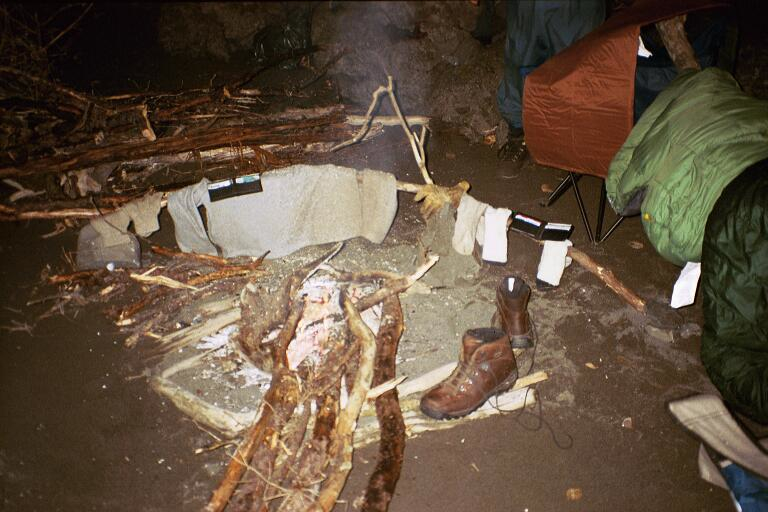
Kangaroo camp is really the last good camp before Kispiox. In fact there’s sacred native ground down river that you aren’t allowed to set foot on. The bad part is you’re still about 40 miles from the take-out at Kispiox, so our original plan was to be closer to the take-out. River carnage did set us back a few miles.
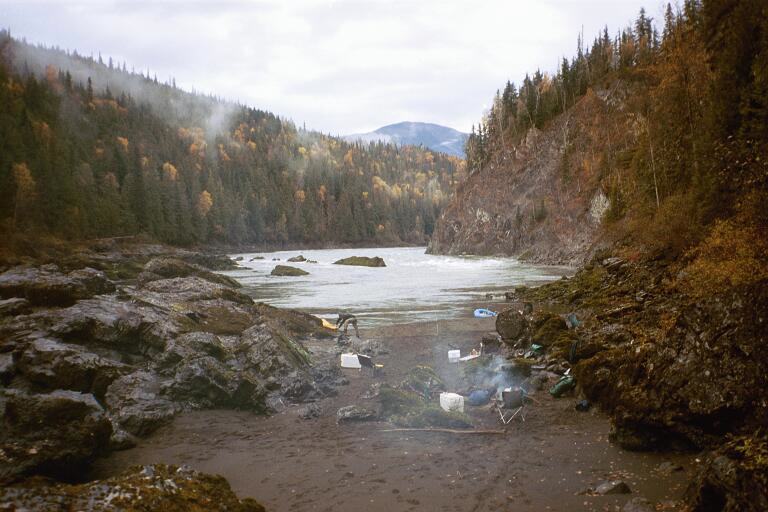
Kangaroo Camp to Kispiox, BC to Portland, OR to Boise, ID
We woke up early knowing the day ahead was going to be long and arduous. The original plan was to camp at Hike camp another 20 miles down river, but chasing boats after the sphincter2 carnage set us back. Remember, our shuttle driver advised us not leave our car at the take-out, so he was going to be waiting for us. We knew that a 40 mile float was going to take some serious rowing for home. Right around the corner from Kangaroo Camp was a class IV rapid called “Go Right or Die”. There are many rapids with names like this, but since it was supposedly class IV, we decided to do a quick scout. It wasn’t much of a rapid and the right channel was the line.
There were no more rapids to encounter on this trip. Instead, we encounterd slow water, back eddies, and whirlpools like I’ve never seen. The last 30 miles was like floating in a lake with no current and at times the back eddies would push you upriver. After a good 12 hours of heavy rowing, we made it and connected with our shuttle driver.
There were drunk natives on that beach everywhere. As we loaded gear, we had to keep eyes on everything. We loaded up and took the hour long drive back to Smithers to drop our shuttle driver off. We gave him a healthy tip for the wait at Kispiox and he returned a kind gesture of smoked salmon that tasted amazing.
We immediately departed Smithers for Portland, OR. It was midnight as we departed Smithers, and the stink was unbearable. We hadn’t showered in nine days, and we had 30 hours of driving ahead of us. Ben drove since he didn’t have to row earlier in the day while Derek and I slept. We were awoken by our vehicle coming to a stop and Ben rolling down the window. In the middle of nowhere, Canadian wildlife and fisheries had a checkpoint stopping every car coming through. Four officers surrounded our rig on all sides asking what we were doing. Fishing came up and they asked for licenses, which we provided and asked how many fish we kept. “Catch and release” was our response, but then they smelled the smoked salmon from our shuttle driver. We proceeded to unload every last item in our trailer including every dry bag to prove we didn’t poach any salmon. To make things worse, they went back to their truck without helping us pack up any of the gear they searched. Just one more set back.
Hours later we crossed the border and continued on to Portland. I was dropped off and happy to be home. Derek and Ben continued on to Boise. At the half way point, on the pass over the Blue Mountains, the Chevy Blazer had the engine light come on and there was a grinding sound in the engine. They waited hours on the pass for help. Derek’s Dad is a trooper and drove the 4 hours from Boise to pick up the guys and trailer, while the Blazer was towed to Pendelton for repairs.
Mission accomplished. Cheers!
